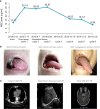Durable Response to Immunotherapy With Antiangiogenic Drug in Large-Cell Lung Carcinoma With Multiple Fulminant Postoperative Metastases: A Case Report
- PMID: 34094914
- PMCID: PMC8173040
- DOI: 10.3389/fonc.2021.633446
Durable Response to Immunotherapy With Antiangiogenic Drug in Large-Cell Lung Carcinoma With Multiple Fulminant Postoperative Metastases: A Case Report
Abstract
Immunotherapy alone or chemo-immunotherapy has recently been recommended for treating advanced lung carcinoma in patients without driver mutations. However, the efficacy of immunotherapy and molecular mechanism in large-cell lung cancer (LCLC) remains unclear. Here, we reported a rare case of multiple fulminant postoperative body and mouth metastases in LCLC treating with combination immunotherapy. Initially, the patient was diagnosed as early stage LCLC and underwent a radical resection of the right lower lobe. Just one month later, multiple fulminant body and mouth lesions appeared in the right upper arm, right elbow, right waist, and tongue root. Meanwhile, serum neuron specific enolase (NSE) concentration dramatically increased from 12.12 to 30.14 ng/ml. Immumohistochemistry findings demonstrated moderate PD-L1 expressions with tumor proportion score (TPS), while next-generation sequencing indicated moderate tumor mutational burden (TMB) levels and gene mutations in PBRM1 L1230P and TP53 L194R of both foci. Besides, loss of heterozygosity (LOH) at human leukocyte antigen (HLA) class I (HLA-A*02:03, HLA-B*55:02 and HLA-C*12:03) were detected in the right upper arm metastasis, which may facilitate malignant postoperative metastases in this case. Notably, this patient received combination therapy with anti-PD-1 antibody sintilimab plus anlotinib, and achieved a partial response for at least 12 months. Using an integrated computational method, the mutant peptide TEIPENDIPL derived from PBRM1 L1230P was predicted to be a specific neoantigen and could still be presented by HLA-B*40:01. This case suggests that immunotherapy plus antiangiogenic drug may provide an alternative therapeutic option for advanced LCLC patients without common gene mutations.
Keywords: antiangiogenic drugs; immunotherapy; large-cell lung carcinoma; loss of heterozygosity at HLA; multiple postoperative metastases.
Copyright © 2021 Luo, Zhang, Xiao, Wang, Zhang, Huang, Cao, Sun, Zhao, Lin, Wu and Wang.
Conflict of interest statement
YX, CS, YZ, HL and DW were employed by YuceBio Technology Co. Ltd. The remaining authors declare that the research was conducted in the absence of any commercial or financial relationships that could be construed as a potential conflict of interest.
Figures


Similar articles
-
Case report: Sintilimab combined with anlotinib as neoadjuvant chemotherapy for metastatic bone tumor resection in patients with PSC.Front Immunol. 2024 May 2;15:1372279. doi: 10.3389/fimmu.2024.1372279. eCollection 2024. Front Immunol. 2024. PMID: 38756778 Free PMC article.
-
Case Report: Therapeutic Response to Chemo-Immunotherapy in an Advanced Large Cell Lung Carcinoma Patient With Low Values of Multiple Predictive Biomarkers.Front Immunol. 2021 Jan 28;11:607416. doi: 10.3389/fimmu.2020.607416. eCollection 2020. Front Immunol. 2021. PMID: 33584678 Free PMC article.
-
Case Report: Advanced pulmonary sarcomatoid carcinoma with adrenal gland metastasis after sintilimab combined with anlotinib treatment.Front Oncol. 2023 Jun 30;13:1167516. doi: 10.3389/fonc.2023.1167516. eCollection 2023. Front Oncol. 2023. PMID: 37456237 Free PMC article.
-
Pembrolizumab combined with anlotinib improves therapeutic efficacy in pulmonary sarcomatoid carcinoma with TMB-H and PD-L1 expression: a case report and literature review.Front Immunol. 2023 Oct 23;14:1274937. doi: 10.3389/fimmu.2023.1274937. eCollection 2023. Front Immunol. 2023. PMID: 37936698 Free PMC article. Review.
-
To be, or not to be: the dilemma of immunotherapy for non-small cell lung cancer harboring various driver mutations.J Cancer Res Clin Oncol. 2023 Sep;149(12):10027-10040. doi: 10.1007/s00432-023-04919-4. Epub 2023 Jun 1. J Cancer Res Clin Oncol. 2023. PMID: 37261523 Free PMC article. Review.
Cited by
-
Efficacy of combined surgery and pembrolizumab for the treatment of pulmonary large cell carcinoma: a case report.Front Immunol. 2024 Dec 23;15:1500996. doi: 10.3389/fimmu.2024.1500996. eCollection 2024. Front Immunol. 2024. PMID: 39763670 Free PMC article.
-
Neoantigen-targeted TCR-engineered T cell immunotherapy: current advances and challenges.Biomark Res. 2023 Dec 1;11(1):104. doi: 10.1186/s40364-023-00534-0. Biomark Res. 2023. PMID: 38037114 Free PMC article. Review.
-
Response to Immune Checkpoint Inhibitors Is Affected by Deregulations in the Antigen Presentation Machinery: A Systematic Review and Meta-Analysis.J Clin Med. 2022 Dec 31;12(1):329. doi: 10.3390/jcm12010329. J Clin Med. 2022. PMID: 36615128 Free PMC article. Review.
-
A novel stratification framework based on anoikis-related genes for predicting the prognosis in patients with osteosarcoma.Front Immunol. 2023 Jul 27;14:1199869. doi: 10.3389/fimmu.2023.1199869. eCollection 2023. Front Immunol. 2023. PMID: 37575253 Free PMC article.
References
-
- Travis W, Brambilla E, Nicholson A, Yatabe Y, Austin J, Beasley M, et al. . The 2015 World Health Organization Classification of Lung Tumors: Impact of Genetic, Clinical and Radiologic Advances Since the 2004 Classification. J Thorac Oncol (2015) 10:1243–60. 10.1097/JTO.0000000000000630 - DOI - PubMed
Publication types
LinkOut - more resources
Full Text Sources
Research Materials
Miscellaneous

